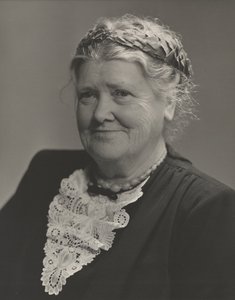Astrid Cleve facts for kids
Quick facts for kids
Astrid Cleve von Euler
|
|
|---|---|
 |
|
| Born |
Astrid Maria Cleve
22 January 1875 |
| Died | 8 April 1968 (aged 93) Västerås, Sweden
|
| Citizenship | Swedish |
| Alma mater | Uppsala University |
| Known for | Comprehensive studies of Scandinavian diatoms |
| Spouse(s) | |
| Children | 5 (including Ulf von Euler) |
| Scientific career | |
| Fields | botany, chemistry, and geology |
| Institutions | Stockholm University, Uddeholm Company, Skoghallsverkens laboratory, Uppsala University |
| Thesis | Studier öfver några svenska växters groningstid och förstärkningstadium (1898) |
| Author abbrev. (botany) | A.Cleve |
Astrid Maria Cleve von Euler (born January 22, 1875 – died April 8, 1968) was a Swedish botanist, geologist, and chemist. She was also a researcher at Uppsala University. Astrid Cleve von Euler was the first woman in Sweden to earn a doctoral degree in science.
Contents
Life and Education
Astrid Maria Cleve was born on January 22, 1875, in Uppsala, Sweden. Her family was very academic. Her father, Per Teodor Cleve, was a famous chemist, oceanographer, and geologist. Her mother, Alma Cleve, was an author and a strong supporter of women's rights and education.
Astrid and her younger sisters, Agnes and Célie, were taught at home by their mother. Their mother was one of the first women in Sweden to finish high school. From age 11 to 13, Astrid attended a boarding school in Lausanne. After that, she finished her high school studies at home.
Her father taught her the basics of science in his laboratory. He studied tiny water organisms called plankton. This sparked Astrid's interest in diatoms, which are a type of algae. She finished her high school studies at 16.
In 1891, Astrid started studying natural science at Uppsala University. She earned her bachelor's degree in 1894.
Early Career and Family
After graduating, Astrid worked as an assistant chemistry professor at Stockholm University. This university was known for hiring women. There, she met Hans von Euler-Chelpin, a German-Swedish biochemist. He later won a Nobel Prize.
Astrid and Hans married in 1902, and she became Astrid Cleve von Euler. They had five children, including Ulf von Euler, who also became a Nobel Prize winner in Physiology. Their marriage ended in 1912.
After leaving Stockholm University, Astrid became a teacher. She taught at several schools in Stockholm from 1911 to 1917. During this time, she also continued her research.
Research and Later Life
From 1917 to 1923, Astrid moved to Värmland. She became the head of a forestry laboratory called Skoghallsverkens Forskningslaboratorium. This lab was part of the Uddeholm Company. Here, she continued her important research.
Later, Astrid and her family moved back to Uppsala for three years. In 1933, they moved to a farm in Lindesberg where they raised sheep. Astrid also taught at a local school to support her family.
In 1949, the family returned to Uppsala, where Astrid spent most of her later years. She passed away on April 8, 1968, at the age of 93.
Scientific Achievements
Astrid Cleve von Euler made many important discoveries in chemistry, botany, and geology.
Chemistry and Diatom Studies
Astrid's early research, starting in 1895, focused on diatoms found in lakes in northern Sweden. She identified and drew new diatoms from Arctic lakes. She also studied how plants in the far north adapted to the cold environment.
Between 1896 and 1898, she published four papers on chemistry. These papers were about nitrogen-containing organic compounds. She also studied the element ytterbium at Uppsala University. She discovered its atomic weight and other properties.
In May 1898, at 23 years old, Astrid earned her doctoral degree from Uppsala University. Her thesis was about the germination and early growth of Swedish plants. She was the second Swedish woman to get a doctorate, and the first in a scientific field.
From 1898 to 1902, she worked as an assistant professor of chemistry at Stockholm University. She published papers on lanthanum and selenium. After marrying Hans von Euler-Chelpin, she published 16 more papers with him. They studied various chemical compounds and industrial processes.
While teaching, Astrid continued her research on plankton. She published major studies on the water plants near Stockholm in 1910 and 1912. These studies are still important today because they show what the diatoms were like before pollution affected the area.
Later, at the Uddeholm Company's forestry lab, Astrid published 23 papers between 1920 and 1925. Her work focused on the chemistry of lignin, a substance found in wood. She also wrote a popular science book about selenium and a textbook on biochemistry.
Geology and Later Diatom Studies
In the 1920s, Astrid's research shifted to both living and fossil diatoms in the Baltic Sea. She also studied how the Baltic Sea's water level changed after the last Ice Age.
She published several important books on diatom classification between 1932 and 1955. Her 1932 book described 535 diatom species found in the Täkern Basin. Two years later, she published on 673 diatom species from northern Finland, many of which were new discoveries.
Her most comprehensive work, Die Diatomeen von Schweden und Finnland, was published in 1951. This book, which took over a decade to write, is still used today. It covers about 1600 diatom species, including their classification, where they live, their environment, and their fossils.
After returning to Uppsala University in 1945, Astrid contributed theories about the Baltic Sea's water level changes. She lectured on diatomology (the study of diatoms) from 1947 to 1948.
In 1948, she received an honorary degree from Uppsala University. She was the first woman in Sweden to receive this special "Jubilee Doctor of Philosophy" award. In 1955, she was given an honorary professorship for her work on diatoms. Astrid Cleve von Euler continued to publish scientific papers until she was 86 years old.
See also
 In Spanish: Astrid Cleve para niños
In Spanish: Astrid Cleve para niños

